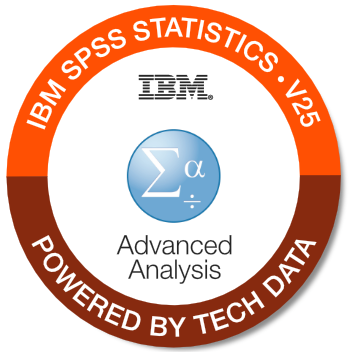
- #Using ibm spss statistics how to
- #Using ibm spss statistics pdf
- #Using ibm spss statistics full
* I declare that I agree to receive commercial and marketing information in electronic form, by phone from Compendium - Centrum Edukacyjne Spółka z o.o.
#Using ibm spss statistics full
(Dz.U.2016.922 as amended) and Regulation of the European Parliament and of the Council (EU) 2016/679 of 27 April 2016 on the protection of individuals with regard to the processing of personal data and on the free movement of such data, and repeal of Directive 95/46 / EC (RODO), Compendium - Centrum Edukacyjne will make every effort to ensure the correct operation of the notification system and storage of personal data located on the server and their full protection.

Tatarska 5, 30-103 Krakow for statistical and marketing purposes in accordance with the Law on the Protection of Personal Data of. Tatarska 5, 30-103 Kraków on the terms set out in the provisions of the Act of 18 July 2002 on the provision of electronic services (Dz.U.2017.1219, ie with later changes) and on the collection, processing and use of given personal data by Compendium - Centrum Edukacyjne Spółka z oo ul. Tatarska 5, 30-103 Kraków to the e-mail address provided above and to process the personal data provided in the Compendium database - Centrum Edukacyjne Spółka z o.o. I declare that I agree to receive the newsletter in electronic form from Compendium - Centrum Edukacyjne Spółka z o.o.
#Using ibm spss statistics pdf
Overview of models to create natural groupings Download conspect training as PDF. Bayesian procedures in IBM SPSS Statistics. Evaluate a null hypothesis: Bayes Factor. Bayesian statistics versus classical test theory. Include categorical independent variables. Explain unstandardized and standardized coefficients. Assumptions for testing on the correlation. Chart the relationship between two scale variables. Test the relationship between scale variables Identify differences between group means: Post-hoc tests. Test the hypothesis of equal group means: One-Way ANOVA. Test on differences between more than two group means Assumptions of the Independent-Samples T Test. Test on the difference between two group means: Independent-Samples T Test. Describe the relationship: Compare group means. Chart the relationship between the group variable and scale variable. Compare the Independent-Samples T Test to the Paired-Samples T Test. Test on the difference between two group means Measure the strength of the association. Test the relationship: The Chi-Square test in Crosstabs. Describe the relationship: Compare percentages in Crosstabs. Chart the relationship between two categorical variables. Test the relationship between categorical variables Tests on a single variable: One-Sample T Test, Paired-Samples T Test, and Binomial Test. Construct a confidence interval for the population mean. Test a hypothesis on the population mean. Examine the distribution of the sample mean. Identify population parameters and sample statistics. Test hypotheses about individual variables Identify the steps in the research process.  Anyone who wants to refresh their knowledge and statistical experience. Anyone who has worked with IBM SPSS Statistics and wants to become better versed in the basic statistical capabilities of IBM SPSS Statistics Base. Test the relationship between scale variables. Test on differences between more than two group means. Test on the difference between two group means. Test the relationship between categorical variables. Test hypotheses about individual variables.
Anyone who wants to refresh their knowledge and statistical experience. Anyone who has worked with IBM SPSS Statistics and wants to become better versed in the basic statistical capabilities of IBM SPSS Statistics Base. Test the relationship between scale variables. Test on differences between more than two group means. Test on the difference between two group means. Test the relationship between categorical variables. Test hypotheses about individual variables. #Using ibm spss statistics how to
Students will gain an understanding of when and why to use these various techniques as well as how to apply them with confidence, interpret their output, and graphically display the results. This includes a broad range of techniques for exploring and summarizing data, as well as investigating and testing relationships. Students will review several statistical techniques and discuss situations in which they would use each technique, how to set up the analysis, as well as how to interpret the results. This course provides an application-oriented introduction to the statistical component of IBM SPSS Statistics.






 0 kommentar(er)
0 kommentar(er)
